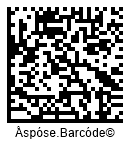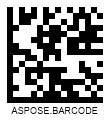Analyzing your prompt, please hold on...
An error occurred while retrieving the results. Please refresh the page and try again.
Data Matrix is a 2D matrix symbology used to generate barcodes of rectangular and square shapes. It is a widespread industrial standard that can be used to encode characters and streams of bytes. Maximum configuration of Data Matrix contains up to 144 rows and columns and allows encoding at most 3,116 numerical digits or 2,335 ASCII symbols or 1,555 bytes. The Data Matrix barcode data includes special information for integrity verification and error correction. The error correction mechanism allows reading barcodes with severe damages. Data Matrix includes two standards described in the table below.
| Data Matrix Standard | Description |
|---|---|
| ECC 000-140 | Several obsolete standards that enable square barcode configuration only, use outdated encoding algorithms and support convolutional error correction. It is recommended not to apply these standards to business-as-usual goals as they currently serve only to execute industrial tasks that are compatible with outdated instructions |
| ECC 200 | Modern standard that enables both square and rectangular barcode configurations, utilizes up-to-date encoding methods and supports Reed-Solomon error correction. It is applicable to any up-to-date application |
To enable the required Data Matrix standard, developers can use the setDataMatrixEcc method of class DataMatrixParameters. This method allows setting one of the supported standards: ECC 000-140 (outdated standards) or ECC 200 (recent universal standard) using the values available in the DataMatrixEccType enum. The value of DataMatrixEccType.ECC_200 is set by default.
Aspose.BarCode for Python allows explicitly setting the ECC 200 standard by calling the setDataMatrixEcc method and passing values ECC_AUTO or ECC_200. ECC 200 is conpatible with all encoding modes specified in the DataMatrixEncodeMode enum. Moreover, it allows encoding Unicode characters through the setCodeTextEncoding method. The capacity of additional recovery information required for error correction is precisely limited for barcodes according to their size.

ECC 000-140 standards can be applied only to a few encoding modes included in the DataMatrixEncodeMode enum, i.e. AUTO, FULL, and ASCII. All other encoding modes are processed as FULL by default. The setCodeTextEncoding method is not applicable to these standards and therefore, encoding Unicode characters is not supported. Barcode layout confirgurations of ECC 000-140 differ significantly from ECC 200. At the same time, different standards corresponding to ECC 000-140 are quite similar between each other and only have different data recovery capacity, as explained below.
| ECC Standard | Data Recovery Capacity |
|---|---|
| ECC_000 | Only error detection |
| ECC_050 | 2.8% |
| ECC_080 | 5.5% |
| ECC_100 | 12.6% |
| ECC_140 | 25% |

Aspose.BarCode for Python via Java supports various encoding modes that are defined in the DataMatrixEncodeMode enum of class DataMatrixParameters. This enum provides nine encoding modes, as described below. The AUTO encoding mode is used by default.
| Encoding Mode | Description |
|---|---|
| AUTO | Similar to ASCII |
| ASCII | Encodes both ASCII characters and streams of bytes; characters from 128 to 255 are encoded with two bytes. The FULL mode is recommended to encode streams of bytes |
| FULL | Encodes any symbol in 8 bits. This mode is recommended to encode byte streams |
| CUSTOM | Uses the encoding determined in BarCodeBuilder.CodeTextEncoding; thereafter, the generated stream of bytes is further processed through the FULL mode |
| C40, TEXT, EDIFACT, and ANSIX12 | Encode predefined sets of symbols through special industrial encodings, i.e. C40, Text, EDIFACT, and ANSI X12 |
| EXTENDED_CODETEXT | Gives flexible control over encodings and allows setting the required encoding for a part of the input message manually |
For all encoding modes except CUSTOM, the encoding determined in BarCodeBuilder.CodeTextEncoding is used to process input information that includes a Unicode symbol (any character with the value over 255). The CUSTOM mode is enabled in the ECC 200 standard only. Further in the article, it is explained how to manage different encoding modes.
AUTO and ASCII encoding modes allow encoding ASCII symbols and byte streams. However, encoding characters from 128 to 255 takes two bytes for each character. In cases when input text includes Unicode symbols, information needs to be re-encoded with the use of the encoding determined in BarCodeBuilder.CodeTextEncoding.

The FULL mode is used to encode streams of bytes. In this mode, each byte is encoded with 8 bits. If input barcode data contains Unicode characters, information gets re-encoded with the encoding set in BarCodeBuilder.CodeTextEncoding. It is possible to represent text lines by calling the setTwoDDisplayText method.

In all cases, the CUSTOM encoding mode implies first re-encoding barcode information into a stream of bytes. Thereafter, the generated stream gets processed in the FULL mode; here, each byte is encoded using 8 bits.

The EXTENDED_CODETEXT mode allows encoding input data applying various encodings to different parts of barcode text if requested by specific industrial standards. It is possible to combine different supported encodings, i.e. AUTO, ASCII, C40, TEXT, ANSIX12, and EDIFACT.
It is necessary to formulate a barcode text message using the following form: "\Encoding_mode_name:text\Encoding_mode_name:text". It is necessary to double all backslashes in text. To display the text message under a barcode, it is required to call the setTwoDDisplayText method.

Various special encoding modes, such as TEXT, C40, EDIFACT, and ANSIX12, can be used to encode barcode information in forms compatible with specific industrial requirements. These modes are applicable to industrial tasks only.

The layout for Data Matrix barcode generation can be determined through setRows and setColumns methods of class DataMatrixParameters. If these methods have not been called explicitly, Aspose.BarCode for Python via Java identifies a layout that is optimal for the size of input data. Barcode layout configurations are different in ECC 000-140 and ECC 200 standards. Only ECC 200 allows modifying the number of rows and columns. In ECC 000-140 standards, the suitable barcode layout configuration is determined automatically. The ECC 200 standard prescribes setting even numbers of rows and columns. In other words, it supports the following layout configurations: 8 x 18; 16 x 48; 10 x 10; 144 x 144.
Layout Settings |
22 Rows and 22 Columns |
12 Rows and 36 Columns |
|---|---|---|
 |
 |
Aspose.BarCode for Python via Java supports the use of macro characters in Data Matrix barcodes. The Data Matrix standard allows encoding industry-specific headers and trailers in a single character. This feature leads to the reduction of the number of symbols for data encoding owing to the use of dedicated structured formats. Macro characters can be useful to implement particular industrial needs. It is necessary to put a macro character in the first digit position.

Aspect Ratio is one of the most important parameters defined as the ratio between barcode height and width. Aspose.BarCode for Python via Java provides the setAspectRatio method of class DataMatrixParameters that allows managing barcode proportions based on the X and Y coordinates. Aspect Ratio is determined as a relative coefficient to XDimension. Usually, it is recommended to set the value of Aspect Ratio equal to 1.
| Aspect Ratio | Is Set to 1 | Is Set to 0.5 |
|---|---|---|
 |
 |
Analyzing your prompt, please hold on...
An error occurred while retrieving the results. Please refresh the page and try again.